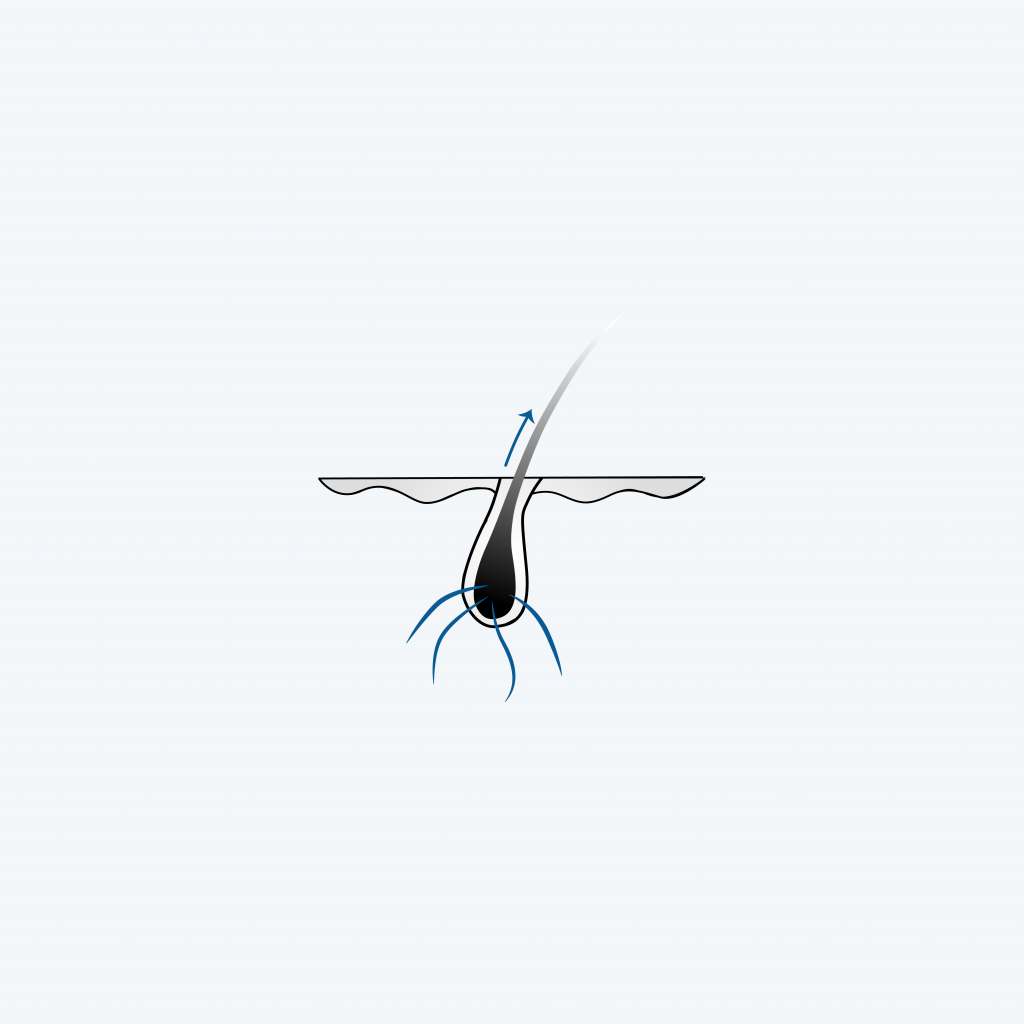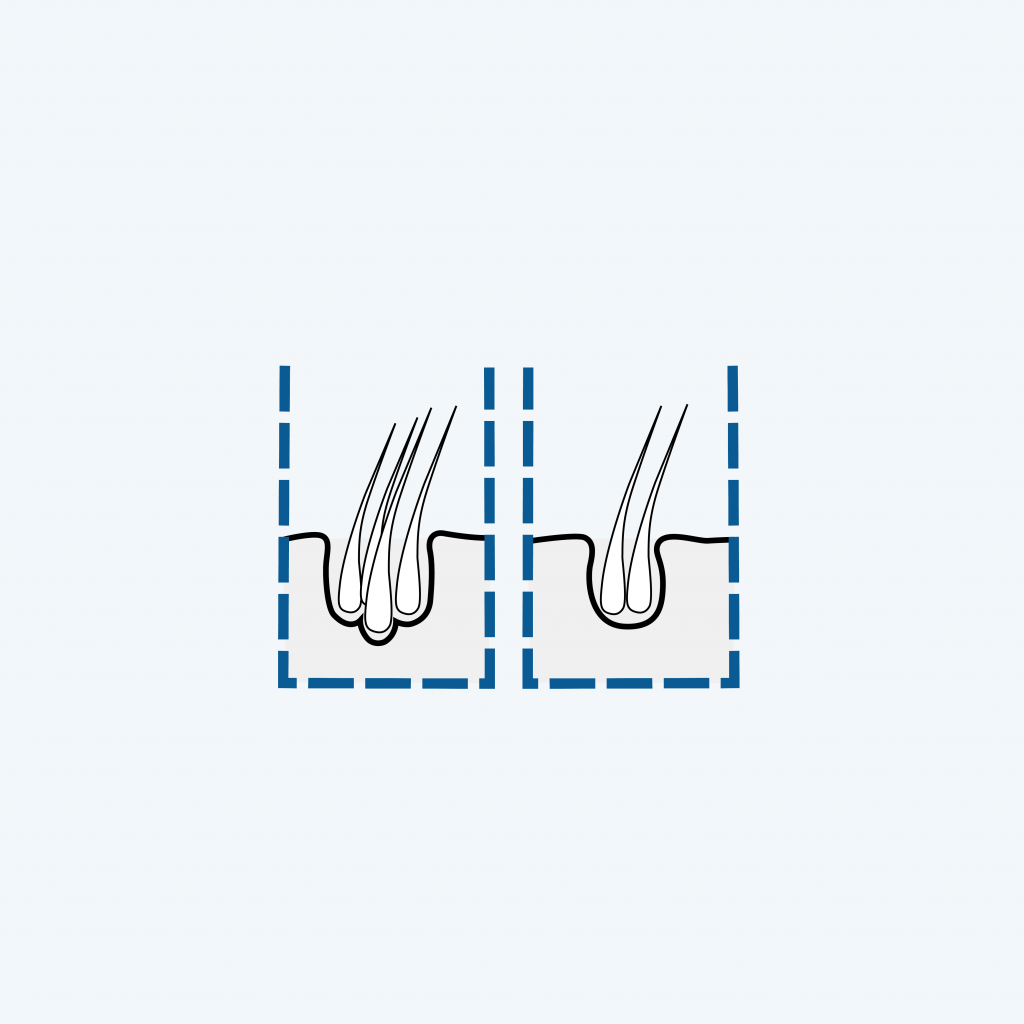Anagen
Growth phase
During the anagen phase, hairs grow. Approximately 85-90% of all hair on the head is in this phase.
The anagenic growth phase is genetically determined. Some people have a longer growth phase while others have a shorter one.

Hair shafts have an onion-shaped root that is enclosed by a hair follicle.
A hair has no nerves and there is no blood in a hair. Therefore, you can say that hair is dead and you can cut it however you want without feeling any pain.
Hair grows fastest between the ages of 15 and 35, with an average hair growth of about 1 cm per month.
The older you get, the slower your hair grows and the hair becomes thinner because the hair follicle shrinks with age.
For some people, hair begins to thin at an early age, for others it takes longer.
Read more about hereditary hair loss
Anagen
During the anagen phase, hairs grow. Approximately 85-90% of all hair on the head is in this phase.
The anagenic growth phase is genetically determined. Some people have a longer growth phase while others have a shorter one.

Katagen
After the anagen phase, the hair enters the catagen phase.
This phase includes the process when the hair begins to detach from its root (so-called transition).
The older we get, the longer the catagen phase, but it usually lasts between 1-6 months.

Telogen
After the catagen phase, the hair goes into a resting phase, the telogen phase. During the resting phase, the hair does not receive any blood supply and stops growing – but remains in the skin.
A new hair begins to form in the hair follicle, underneath the existing one.
The resting phase is short when you are younger but gets longer with age. This leads to thin hair.

Exogen
Strands of hair that have been in dormancy eventually fall off. This is called the exogenous phase.
After that, the hair follicle returns to the anagen phase and a new hair is formed.

The hair loss that occurs with age is due to the natural shrinkage of hair follicles with age. When the hair follicles shrink, a thinner strand of hair is produced.
If the hair follicle becomes too shrunken, hair strands will fall off completely. It is a genetic hair loss that can be prevented by PRP treatment.
When this process begins differs from person to person. For some, it may begin in adolescence, while for others it may occur in middle age or not at all.
Then other causes can trigger hair loss, such as a traumatic event, childbirth, DHTor hair diseases.

We have many clients who come to us with concerns about washing or brushing their hair because they lose more hair that way.
The hairs that go with you when you shower or brush your hair are hairs that are already in a resting or transitional phase.
Hair in the growth phase is very difficult to remove and it hurts to pull it off. For example, this is why it hurts to knot your eyebrows and why you can pull your hair without it all falling off.
The hair that comes with brushing is not felt at all.
So you don’t have to worry about pulling hair out when combing or washing your hair.

A hair transplant involves a hair technician moving a hair follicle from one place to another. Usually the hair follicle group is taken from the back of the head, in the area above the neck.
We achieve this by drilling out the existing hair follicle, creating a microchannel in the area it will be transplanted to and placing it there.
The medical term we use when talking about hair follicles is grafts. A graft contains one to several hairs.
The cost of a hair transplant depends on how many grafts we can harvest from your donor area, and this is best seen through a consultation where we go through your circumstances.
There are medicinesthat help with hair loss.
Finasteride(the active ingredient in Propecia) and Minoxidil(the active ingredient in Rogaine) help against hair loss. The medicines work in different ways, but Finasteride should only be used and handled by men as it can cause severe damage to the foetus if it comes into contact with pregnant women.
We can prescribe Finasteride to our customers.
With PRP, we extract the body’s own growth factors, called platelets, which we then inject into the scalp.
The growth factors enlarge the size of the hair follicle, which is often shrunken and has been for a long time (if the hair loss has been going on for a long time). As the size of the hair follicle increases, the hair follicle is able to start producing a hair again of better and stronger quality.
In this way, the treatment can effectively prevent hair loss.
To counteract and stop sudden hair loss, we recommend PRP treatments on a continuous basis.
If you have severe hair loss and would like to adjust your hairline or fill out your hair in some place, we recommend that you come in for a consultation to get help with your hair loss and talk about a possible hair transplant.
Yes. When the body is exposed to a lot of stress over a long period of time, the hair follicles may go into resting phase as a form of self-defence.
The hair follicles then die 3 – 6 months after the event that triggered the resting phase. This can make it difficult to trace stress as the contributing factor to hair loss. When the hair follicle dies, the hair falls off.